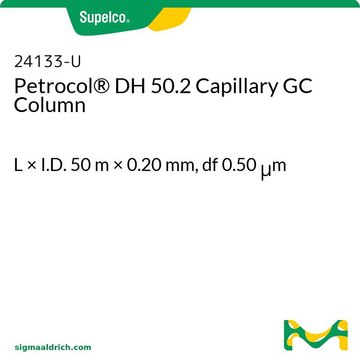24282
Petrocol® DH Octyl
L × I.D. 100 m × 0.25 mm, df 0.50 μm
About This Item
Productos recomendados
material
fused silica
agency
ASTM® D6729,D6730,D6773
parameter
-60-220 °C temperature (isothermal or programmed)
Beta value
125
df
0.50 μm
technique(s)
gas chromatography (GC): suitable
L × I.D.
100 m × 0.25 mm
matrix active group
Bonded; poly(50% n-octyl/50% methyl siloxane) phase
application(s)
chemicals and industrial polymers
petroleum
column type
capillary non-polar
General description
USP Code: None
Phase:
- Bonded
- Poly(50% n-octyl/50% methyl siloxane)
- -60 °C to 220 °C (isothermal or programmed)
Other Notes
Legal Information
Elija entre una de las versiones más recientes:
¿Ya tiene este producto?
Encuentre la documentación para los productos que ha comprado recientemente en la Biblioteca de documentos.
Contenido relacionado
Gas chromatography is a common analytic technique used to separate and analyze volatile compounds in the gas phase. GC is applied in many industries for quality control, and to identify and/or quantify compounds in a mixture.
Gas chromatography separates volatile compounds in the gas phase, applied in various industries for quality control.
Nuestro equipo de científicos tiene experiencia en todas las áreas de investigación: Ciencias de la vida, Ciencia de los materiales, Síntesis química, Cromatografía, Analítica y muchas otras.
Póngase en contacto con el Servicio técnico